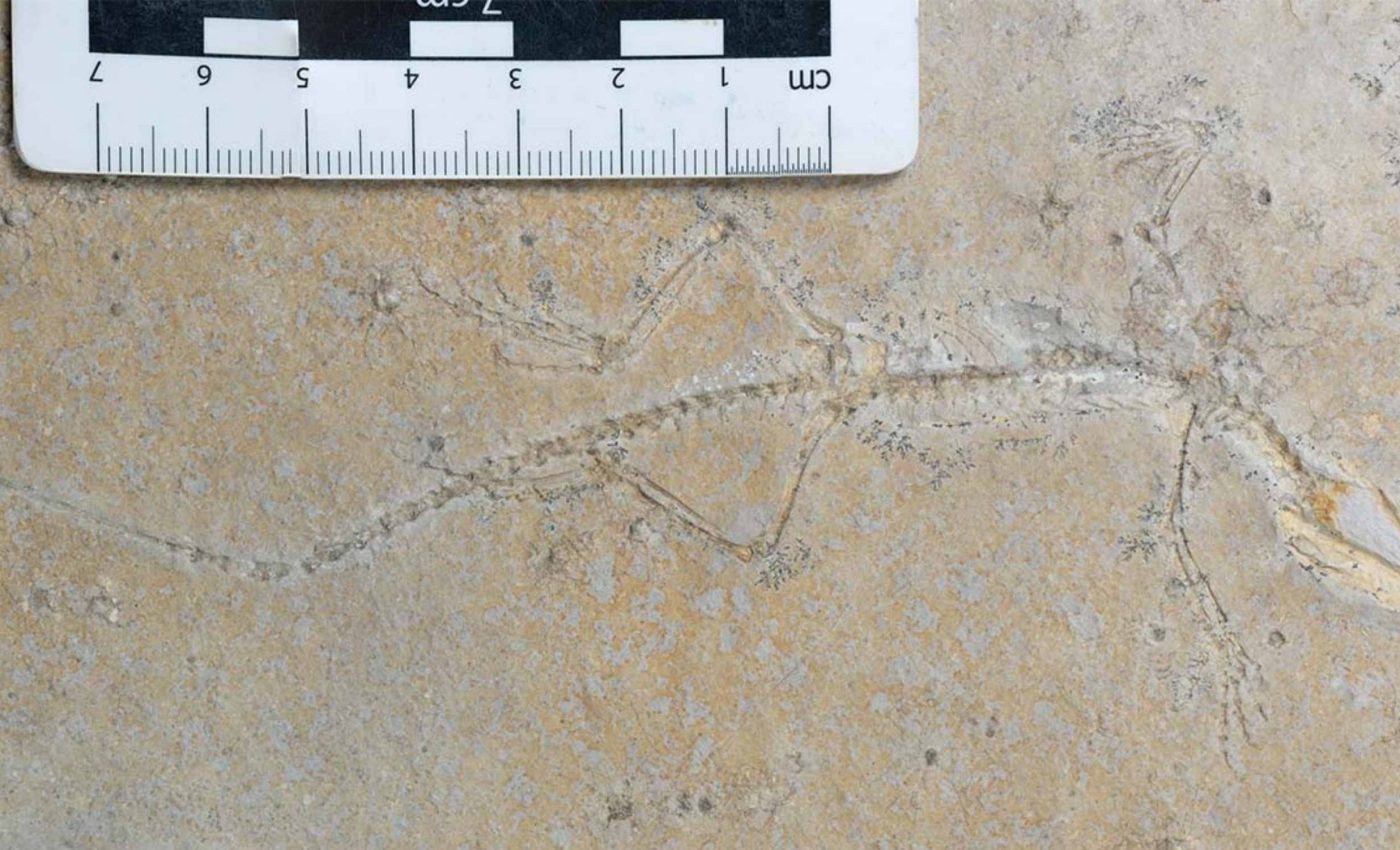
New species discovered when two halves of a fossil were rejoined after decades of separation
Two rock slabs, stored in different museums, turned out to be one animal and a new species. Researchers report Sphenodraco scandentis, an early rhynchocephalian tree climber from the Late Jurassic.
One slab preserves the animal’s outline in Frankfurt, and the other preserves most of the bones in London. Lead researcher Victor Beccari of the Natural History Museum in London (NHM).
What makes Sphenodraco different
Sphenodraco has long limbs, a short body, and unusually long finger bones that suit climbing in complex habitats.
The teeth are set at a slightly oblique angle and the hip bears a square socket, a combination that separates it from lookalike fossils in the same rocks.
Comparative bone analysis shows how shape and proportions across the group can track lifestyle and relationships. In this case, limb measurements and body ratios line up with the ranges seen in living climbing lizards.
Researchers emphasize the role of postcranial anatomy, not just jaws and teeth, for reading behavior in extinct reptiles.
That is why finger length, shoulder form, and hip shape matter as much as bite style when you test how an animal lived.
The team’s dataset places Sphenodraco among species that used narrow perches and vertical surfaces. The proportions push it toward the extreme end of climbing adaptations within its broader family.
Two museums, one whole fossil
“It seems that someone in the 1930s decided to double their profit by selling both halves separately,” said Beccari. He added that the link between the halves had been lost for decades.
That sale left the impression in Frankfurt and the skeleton rich counterslab in London, a split that masked the true identity.
Matching rock textures, break lines, and features across the slabs closed the loop and reunited the animal.
The two halves also corrected an old label. The Frankfurt half had been filed under Homoeosaurus maximiliani, but the full set of features did not fit that species.
With the halves back together, the animal’s proportions and dental details could be checked with confidence. That was the pivot that moved it from a mislabeled specimen to a new name.
Solnhofen and ancient islands
The Solnhofen Limestone is a famous Lagerstätte, a site where fine sediments and quiet, low oxygen waters preserved delicate bodies in remarkable detail. That kind of chemistry slows decay and reduces damage from scavengers.
During the Late Jurassic, Solnhofen was an island chain in a warm sea, so land animals and tree dwellers sometimes washed into lagoons. Their remains settled into thin, even layers of lime mud.
The site is best known for Archaeopteryx and exquisite fish, crustaceans, and plants. It also holds a long record of rhynchocephalians that vary in size and limb form.
That spread of forms makes Solnhofen a testing ground for species boundaries and lifestyles. Sphenodraco adds a tree specialist to that mix.
Sphenodraco is a single survivor
Rhynchocephalians are the sister group to lizards and snakes, and today they survive as the tuatara of New Zealand. Multiple lines of research show they were far more diverse during the Mesozoic.
They filled marine, terrestrial, and possibly semi arboreal niches, while dinosaurs dominated large body sizes. The new fossil helps anchor a climbing lifestyle within the group.
Sphenodraco’s mix of traits supports the idea that ancient islands held many small reptile species. That fits with patterns seen on modern islands.
The find also hints that museum drawers still hold overlooked diversity. Reexamining classic collections can reset long standing labels.
How scientists read a skeleton
Scientists measured limb elements, shoulder and hip dimensions, and the proportions of hands and feet. They then compared those numbers with living lizards that use rocks, ground, or trees to test what matched best.
The results match climbing specialists with long forelimbs and elongated digits. Sphenodraco shows the strongest form of that signal in the fossil sample used by the team.
Looking beyond the head is key because teeth can mislead when species eat similar foods. Skeletons below the skull often carry the clearer map of behavior.
Researchers also point out how crushed skulls or buried bones can obscure traits. Ultraviolet light and fine scale imaging help recover anatomy that is hard to see.
Sphenodraco and museum collections
Micro X-ray CT together with UV imaging made it possible to resolve anatomical structures that were otherwise unclear.
The research also highlighted how important it is to examine every specimen available in museum collections to capture details that might have been overlooked.
Old collections carry context that field sites no longer provide, including exact quarry layers and historic trades. That context lets scientists test whether similar looking fossils really represent one species or several.
Reuniting halves is rare, yet the lesson travels. Careful cross checking across museums, even for specimens long thought to be familiar, can reveal hidden diversity.
Finding a climber among Jurassic rhynchocephalians expands how we picture small reptiles in island forests. It shows that niche variety was not just a feature of lizards and birds in those ecosystems.
The study is published in the Zoological Journal of the Linnean Society.
—–
Like what you read? Subscribe to our newsletter for engaging articles, exclusive content, and the latest updates.
Check us out on EarthSnap, a free app brought to you by Eric Ralls and Earth.com.
—–













